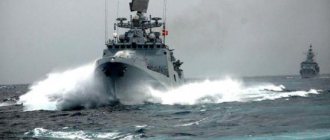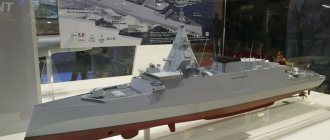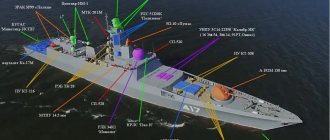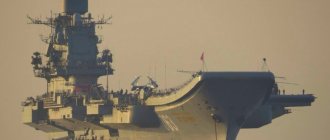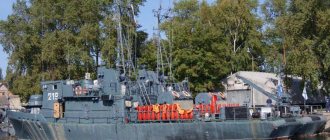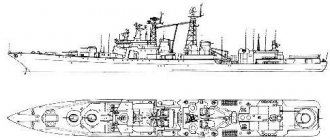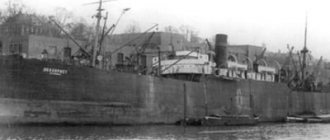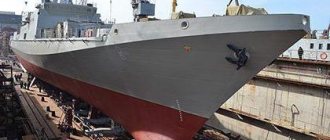TTD:
Displacement: 3860 tons. Dimensions: length - 124.8 m, width - 15.2 m, draft - 4.66 m. Full speed: 30 knots. Cruising range: 4850 miles at 14 knots. Powerplant: 2x6000 hp sustainer turbines, 2x17000 hp afterburner turbines, 2 fixed pitch propellers Armament: 1x8 vertical launcher UKSK (8 Kalibr-NK anti-ship missiles), 2x12 vertical launchers of the Shtil-1 air defense system (24 anti-aircraft missiles), 1x1 100 mm gun mount A-190-01 , 2x6 30 mm AK-630M gun mounts, 8x1 Igla-1 air defense missile system, 2x2 533 mm DTA-53-11356 torpedo tubes, 1x12 RBU-6000 launcher, 1x10 55 mm DP-65 grenade launcher, 1 Ka-27 helicopter. Crew: 220 people.
Ship history:
Frigate pr.11356
Project 11356 frigates are designed to conduct combat operations in oceanic and sea areas independently and as part of a formation of ships as an escort ship. The ship's combat capabilities allow it to search for and destroy enemy submarines; carry out anti-ship, anti-air and anti-submarine defense of warships and vessels at sea; support the combat operations of ground forces and ensure the landing of amphibious assault forces.
The ship's design was developed by the Federal State Unitary Enterprise "Northern Design Bureau" on the basis of the border patrol ship of Project 11351, and was originally intended for a foreign customer - the Indian Navy. According to this project, 6 ships were built for the Indian side at the Shipyards in St. Petersburg and Kaliningrad from 1999 to 2013, 3 units at each Shipyard.
The ship for the Russian Navy was created to accelerate the replenishment of the fleet, as a result of the delay in the implementation of Project 22350, and is intended for the Black Sea Fleet. The order of the Ministry of Defense of the Russian Federation received by the Yantar Shipyard in 2010 envisaged the construction of three frigates of Project 11356, but in the summer of 2011 it became known that the plant would build a total of 6 patrol ships of this project for the Russian Navy.
The ship's hull is forecastle-shaped, with an extended forecastle and fairly full contours in the above-water part of the bow. The ship has a three-island superstructure. The hull and superstructure of the ship are made of steel. When creating the ship, in order to increase its security and survivability, methods of architectural protection were used taking into account stealth technology, and measures were also implemented to reduce acoustic signature and protection from weapons of mass destruction. The main power plant is a two-shaft gas turbine unit of the COGAG type, consisting of two afterburning gas turbine engines (GTE) and two main gas turbine engines operating through complex gearboxes for two fixed-pitch propellers. The total power of the power plant is 56,000 hp.
The ship's armament includes 8 cells of the UKSK universal naval firing system, the A-190 universal automatic 100-mm artillery mount, the Shtil-1 anti-aircraft missile system, and two six-barreled rapid-fire 30-mm AK-630M mounts. The ship's anti-submarine and anti-torpedo protection is provided by two twin-tube 533-mm torpedo tubes and an RBU-6000 rocket launcher. The ship is equipped with a helicopter hangar and a landing pad, and carries on board one Ka-27 helicopter.
The patrol ship "Admiral Grigorovich" was laid down in Kaliningrad at the Baltic Shipyard "Yantar" on December 18, 2010 (serial number 01357), launched on March 14, 2014, and joined the Black Sea Fleet on March 11, 2016. In 2016. was reclassified as a frigate.
After completing the inter-fleet transition from Kaliningrad on 06/09/2016, the ship arrived at its permanent home base - Sevastopol.
On November 3, 2016, the ship left Sevastopol to make the transition to the eastern part of the Mediterranean Sea, where it joined the mixed ship group of the Russian Navy. On November 15, 2016, “Admiral Grigorovich” carried out a combat three-missile salvo with the main missile system against ground-based terrorist infrastructure facilities in Syria. On December 19, 2016, the ship returned to the main base of the Black Sea Fleet - Sevastopol, having covered 9,500 miles during its first combat service.
On February 27, 2017, the ship again left Sevastopol for military service in the Mediterranean Sea. On June 22, 2017, “Admiral Grigorovich” carried out a combat two-missile salvo with its main missile system against ground-based terrorist infrastructure facilities in Syria. On July 12, 2017, the ship returned to the main base of the Black Sea Fleet - Sevastopol.
Currently, the ship is part of the 30th division of surface ships of the Black Sea Fleet and is actively used in combat services in the Mediterranean Sea.
This ship was commanded at different times by: - Captain 2nd rank Areshkin Sergey Gennadievich (11.2014-02.2016); - captain 3rd rank Velichko Anatoly Vasilyevich (02.2016-) - captain 2nd rank Roman Varchenko; - Captain 3rd Rank Konstantin Aksyonov.
Personal characteristics
Admiral Ivan Grigorovich
Admiral Ivan Konstantinovich Grigorovich
Already in the first years of his service, Grigorovich established himself as a competent naval officer, thanks to which he quickly advanced through military service. His organizational skills were most clearly demonstrated during the defense of Port Arthur. On the night of January 27, 1904, the Tsarevich was blown up during a surprise attack by Japanese destroyers. Thanks to Grigorovich’s quick assessment of the situation and the skillful actions of the crew, he not only remained afloat, but also entered into battle with Japanese ships, and then retreated to the port under his own power. Due to the impossibility of quick repairs, the crew of the battleship was partially transferred to other ships. By order of the commander of the Pacific Fleet, Vice Admiral Stepan Osipovich Makarov, the commander of the port of Port Arthur, Rear Admiral Nikolai Romanovich Greve, was removed from office for the disorder and slowness of port work, and Grigorovich was appointed in his place. His new tasks were to provide the port with coal, ammunition, solve logistics problems, and lay minefields. After the capitulation of Port Arthur, only indirect accusations were brought against Grigorovich and other admirals who participated in the defense. They consisted in the fact that the naval officers did not oppose the deliberate surrender of the fortress by General Stoessel.
After the end of the Russo-Japanese War, Grigorovich held various administrative positions, showing considerable energy in the development of port facilities. Under his leadership, the first scuba diving training unit in Russia was created in Libau. Thanks to his fruitful activities, Grigorovich soon occupied the post of Minister of Navy. His work in his new post was aimed at rebuilding the Russian navy and maintaining its combat readiness. Under the leadership of Grigorovich, the maritime department was reorganized and a number of programs were implemented to strengthen the Black Sea and Baltic fleets. On Grigorovich’s initiative, Russia adopted a program for the construction of battleships, and founded its own production of steam turbines, communications equipment, and electrical equipment. The construction time for heavy ships was reduced from 5-7 to 3 years. A shipbuilding conference was created, the scope of which included the distribution of orders for the construction of ships among Russian and foreign shipyards. To improve the conditions of service, a number of decisions were made aimed at increasing the pay of personnel and the conditions of service. At the same time, the minister himself actively took part in various inspections and did his best to eradicate formalism and protectionism.
Admiral Grigorovich during the First World War
With the outbreak of the First World War, under the leadership of Grigorovich, the work of industry was organized in the interests of the fleet, logistics and training of personnel in maritime educational institutions were established. Ivan Konstantinovich initiated the creation of the defense of Petrograd from the Baltic Sea, organized the supply of goods by the Allies through Arkhangelsk and Murmansk, and also decided to create a flotilla of the Arctic Ocean. During the Second World War, all battleships, 40 percent of cruisers and a third of destroyers in service with the USSR Navy were built under Grigorovich.
After the revolution of 1917, Grigorovich turned out to be one of the few ministers of the tsarist government who were not persecuted for their activities by the Cheka.
Fire control systems
Long gone are the days of shooting by eye. Even perfect optical sights no longer satisfy the requirements of military sailors due to the transience of the situation in the naval arena of military operations. Making decisions about opening fire is the prerogative of the commander, and the crew trusts the automation to calculate the parameters of the shot. The ship "Admiral Grigorovich" has on board the most powerful computing systems that serve to quickly aim weapons at the target. The information comes from the Puma radar, the Vympel 123-02 control system handles missile launches, and the Purga-11356 control system is responsible for the torpedoes.
Literature and sources of information
- Grigorovich I.K. Memoirs of a former naval minister
. - St. Petersburg: Deva, 1993. - 220 p. — (Nautical Almanac Library). — 5,000 copies. — ISBN 5-87303-006-5 - Fedorchenko V. I. Imperial House.
Eminent Dignitaries: An Encyclopedia of Biography . - Krasnoyarsk: Bonus, 2003. - 1309 p. — (Chronicles. Portraits. Biographies). — 3,000 copies. — ISBN 5-7867-0048-8 - The case of the surrender of the Port Arthur fortress to Japanese troops in 1904. Report.
. - St. Petersburg: V. Berezovsky Publishing House, 1908. - 481 p. - Stein M. G. Ulyanovs and Lenins: family secrets
. - St. Petersburg: Neva, 2004. - 512 p. — (Secrets of the great ones). — 2,000 copies. — ISBN 5-7654-3608-0 - A. N. Stepanov Port Arthur
. - Moscow: Pravda, 1985. - 672 p. — 1,500,000 copies.
Second patrol ship
The second patrol ship of Project 11356 was the Admiral Essen. Frigate 11356 was created by engineers of the Northern Design Bureau. The ship received its name in honor of Admiral N. O. von Essen. The third ship, Admiral Makarov, is undergoing testing; the construction of the remaining frigates has been suspended due to Ukraine’s failure to supply the necessary equipment.
Design work on the frigate Admiral Essen began in 2011. The laying of the ship was carried out in the Baltic states by employees of the Kaliningrad shipbuilding plant. The frigate was listed under No. 01358.
In the fall of 2014, Admiral Essen was ready for sea trials. On November 7 it was launched as number 751. After successful factory tests in November 2015, the frigate was launched for the first time, and in 2016 it was successfully tested at the state level. On March 23, the ship set sail from the Baltic naval base and set off in the direction of the Northern Fleet.
The frigate was supposed to make an inter-fleet transition. While moving, the crew carried out joint maneuvering with accompanying ships. The inter-fleet transition allowed the sailors to test the ship's navigation, communications and radio equipment. The crew of the Admiral Essen successfully completed the mandatory firing exercises. The vessel's weapons systems were also successfully tested in the Barents Sea. Mandatory state tests were completed in April 2016.
Initially, it was decided that this frigate would be transferred to the Black Sea Fleet at the end of May 2016. It was assumed that this date would be May 26. However, on the 25th it was decided to conduct an additional test. On June 7, 2016, the naval flag was raised on the frigate Admiral Essen. On the same day, the new ship entered service with the Russian Black Sea Fleet.
External links [edit]
- Admiral Grigorovich class frigates on russianships.info
| vteFrigates of the Admiral Grigorovich class | |
| |
| |
| |
What is a “watchman”?
The lead patrol frigate 11356 “Admiral Grigorovich” received its name in honor of Admiral I.K. Grigorovich, who was the Russian Minister of Navy from 1911 to 1917.
Work on the creation of this vessel began in December 2010 at the Yantar slipway in Kaliningrad under serial number No. 01357. In April 2015, frigate 11356 Admiral Grigorovich was ready for testing. This ship was tested until the end of that year. In 2016, after the signing of the acceptance certificate and the raising of the naval flag, frigate 11356 “Admiral Grigorovich” was officially put into service with the Russian Navy. Today it is assigned as a surface patrol ship to the 30th Division of the Black Sea Fleet.
Combat use
The frigate "Admiral Grigorovich" launches a "Caliber" missile at targets in Syria
In addition to repeated participation in various exercises and maneuvers, the frigate Admiral Grigorovich was used several times to strike real targets. They were objects belonging to terrorist groups operating in Syria.
To destroy targets, the ship used Caliber missiles, launching from the Mediterranean Sea. The first time this happened was in mid-November 2016. At the end of June 2022, “Admiral Grigorovich” again attacked terrorists, and two months later a third missile strike took place. According to official information, the targets of terrorist groups were successfully hit in all cases.


